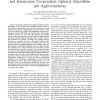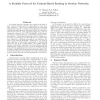103
Voted
CDC
2009
IEEE
15 years 5 months ago
2009
IEEE
—The paper addresses the problem of massive content distribution in the network where multiple sessions coexist. In the traditional approaches, the sessions form separate overlay...
76
Voted
P2P
2002
IEEE
15 years 5 months ago
2002
IEEE
In most peer-to-peer systems, edge resources self-organize into overlay networks. At the core of Freenet-style peer-to-peer systems are insert and request algorithms that dynamica...
94
Voted
INFOCOM
2002
IEEE
15 years 5 months ago
2002
IEEE
— A number of large-scale distributed Internet applications could potentially benefit from some level of knowledge about the relative proximity between its participating host no...
97
Voted
HPDC
2002
IEEE
15 years 5 months ago
2002
IEEE
We describe a decentralized, adaptive mechanism for replica location in wide-area distributed systems. Unlike traditional, hierarchical (e.g, DNS) and more recent (e.g., CAN, Chor...
102
click to vote
WISE
2003
Springer
15 years 5 months ago
2003
Springer
Advancement in wireless infrastructure for data access through third generation wireless and wi-fi technologies makes it possible to use mobile devices for various activities and ...
96
Voted
NCA
2003
IEEE
15 years 5 months ago
2003
IEEE
In content networks, messages are routed on the basis of their content and the interests (subscriptions) of the message consumers. This form of routing offers an interesting alte...
103
Voted
INFOCOM
2003
IEEE
15 years 5 months ago
2003
IEEE
Abstract— Distributed hash table (DHT)-based overlay networks, represented by Pastry, CAN, and Chord, offer an administration-free and fault-tolerant application-level overlay ne...
126
click to vote
INFOCOM
2003
IEEE
15 years 5 months ago
2003
IEEE
— Structured peer-to-peer overlay networks such as CAN, Chord, Pastry, and Tapestry can be used to implement Internet-scale application-level multicast. There are two general app...
127
click to vote
EUROMICRO
2003
IEEE
15 years 5 months ago
2003
IEEE
In this paper we introduce the implementation of a streaming video distribution scheme based on client relay modules. The purpose is the formation and maintenance of an overlay ne...
102
Voted
DSN
2003
IEEE
15 years 5 months ago
2003
IEEE
Abstract— Reliable point-to-point communication is usually achieved in overlay networks by applying TCP/IP on the end nodes of a connection. This paper presents an hopby-hop reli...



